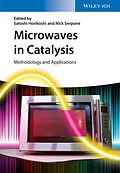A comprehensive overview covering the principles and preparation of catalysts, as well as reactor technology and applications in the field of organic synthesis, energy production, and environmental catalysis.
Edited and authored by renowned and experienced scientists, this reference focuses on successful reaction procedures for applications in industry. Topics include catalyst preparation, the treatment of waste water and air, biomass and waste valorisation, hydrogen production, oil refining as well as organic synthesis in the presence of heterogeneous and homogeneous catalysts and continuous-flow reactions.
With its practical relevance and successful methodologies, this is a valuable guide for chemists at universities working in the field of catalysis, organic synthesis, pharmaceutical or green chemistry, as well as researchers and engineers in the chemical industry.
Autorentext
Satoshi Horikoshi received his PhD degree in 1999 from Meisei University, and was subsequently a postdoctoral researcher at the Frontier Research Center for the Global Environment Science (Ministry of Education, Culture, Sports, Science and Technology) until 2006. He joined Sophia University as Assistant Professor in 2006, and then moved to Tokyo University of Science as Associate Professor in 2008, after which he returned to Sophia University as Associate Professor in 2011. Currently he is Vice-President of the Japan Society of Electromagnetic Wave Energy Applications (JEMEA), and is on the Editorial Advisory Board of the Journal of Microwave Power and Electromagnetic Energy and other international journals. His research interests involve new material synthesis, molecular biology, formation of sustainable energy, environmental protection and CO2-fixation using microwave- and/or photo-energy. He has co-authored over 150 scientific publications and has contributed to and edited or co-edited 20 books.
Nick Serpone obtained his Ph.D. in Physical-Inorganic Chemistry at Cornell University (1964-1968; Ithaca, NY). He joined Concordia University (Montreal) in 1968 as Assistant Professor, was made Associate Professor in 1973, Professor in 1980, University Research Professor (1998-2004), and Professor Emeritus in 2000. He was Program Director at the U.S. National Science Foundation (Washington, DC, 1998-2001) and has been a Visiting Professor at the University of Pavia, Italy, since 2002 and at the Tokyo University of Science, Noda Campus (July- August 2008). His major research interests are in the photophysics and photochemistry of semiconductor metal oxides, heterogeneous photocatalysis, environmental photochemistry, photochemistry of sunscreen active agents, and application of microwaves to nanomaterials and to environmental remediation. He has co-authored over 430 articles and has co-authored, translated or co-edited 9 monographs. In July 2010, he was elected Fellow of the European Academy of Sciences (EurASc), and is currently Head of the Materials Sciences Division of EurASc.
Inhalt
List of Contributors XVII
Preface XXI
1 General Introduction to Microwave Chemistry 1
Satoshi Horikoshi and Nick Serpone
1.1 ElectromagneticWaves and Dielectric Materials 1
1.2 Microwave Heating 2
1.3 The Various Types of Microwave Heating Phenomena 4
1.3.1 Conduction Loss Heating (Eddy Current Loss and Joule Loss) 5
1.3.2 Dielectric Heating 5
1.3.3 Magnetic Loss Heating (Eddy Current Loss and Hysteresis Loss Heating) 6
1.3.4 Penetration Depth of Microwaves 6
1.4 Fields of Applications with Microwave Heating 9
1.5 Microwaves in Solid Material Processing 11
1.6 Microwaves in Organic Syntheses 12
1.7 Microwave Chemical Equipment 12
1.8 Chemical Reactions Using the Characteristics of Microwave Heating 17
1.9 Microwave Frequency Effect in Chemical Syntheses 21
1.10 Summary 25
References 25
Part I Fundamentals 29
2 Loss Mechanisms and Microwave-Specific Effects in Heterogeneous Catalysis 31
A.E. Stiegman
2.1 Introduction 31
2.2 Heterogeneous Catalyst Systems 33
2.3 Physics of Microwave Absorption 33
2.4 Microwave Loss Processes in Solids 35
2.4.1 Dielectric Loss 35
2.4.2 Charge Carrier Processes 36
2.4.2.1 Conduction Loss 36
2.4.2.2 SpaceCharge Recombination 37
2.4.2.3 Dipolar Loss 38
2.4.3 Magnetic Loss Processes 40
2.5 Loss Processes and Microwave-Specific Catalysis: Lessons from GasCarbon Reactions 41
2.5.1 Thermochemical Considerations 42
2.6 Final Comments on Microwave-Specific Effects in Heterogeneous Catalysis 45
Acknowledgments 45
References 46
3 Transport Phenomena and Thermal Property under Microwave Irradiation 49
Yusuke Asakuma
3.1 Introduction 49
3.2 Bubble Formation 50
3.3 Convection 53
3.4 Surface Tension 56
3.5 Discussion of Nonthermal Effect for Nanobubble Formation 58
References 59
4 Managing Microwave-Induced Hot Spots in Heterogeneous Catalytic Systems 61
Satoshi Horikoshi and Nick Serpone
4.1 What Are Hot Spots? 61
4.2 Microwaves in Heterogeneous Catalysis 61
4.3 Microwave-Induced Formation of Hot Spots in Heterogeneous Catalysis 63
4.3.1 Hot Spot Phenomenon 63
4.3.2 Mechanism(s) of Formation of Hot Spots 68
4.3.3 Particle Aggregation by Polarization of Activated Carbon Particulates 69
4.3.4 Control of the Occurrence of Hot Spots 73
References 75
Part II Applications Preparation of Heterogeneous Catalysts 77
5 Preparation of Heterogeneous Catalysts by a Microwave Selective Heating Method 79
Satoshi Horikoshi and Nick Serpone
5.1 Introduction 79
5.2 Synthesis of Metal Catalysts on Carbonaceous Material Supports 79
5.3 Photocatalysts 81
5.3.1 Preparation of TiO2/AC Particles 83
5.3.2 Proposed Mechanism of Formation of TiO2/AC Particles 86
5.3.3 Photoactivity ofMW-Prepared TiO2/AC Composite Particles in the Degradation of Isopropanol 87
5.4 Microwave-Assisted Syntheses of Catalytic Materials for Fuel Cell Applications 88
5.4.1 Microwave-Assisted Synthesis of Pt/C Catalyst Particulates for a H2 Fuel Cell 89
5.4.2 Preparation of Nanocatalysts for a Methanol Fuel Cell 91
5.4.3 Effects of pH on Pt Particle Size and Electrocatalytic Activity of Pt/CNTs for Methanol Electro-oxidation 93
5.5 Other Catalysts Prepared by Microwave-Related Procedures 94
5.6 Concluding Remarks 103
References 103
Part III Applications Microwave Flow Systems and Microwave Methods Coupled to Other Techniques 109
6 Microwaves in Cu-Catalyzed Organic Synthesis in Batch and Flow Mode 111
Faysal Benaskar, Narendra Patil, Volker ...
